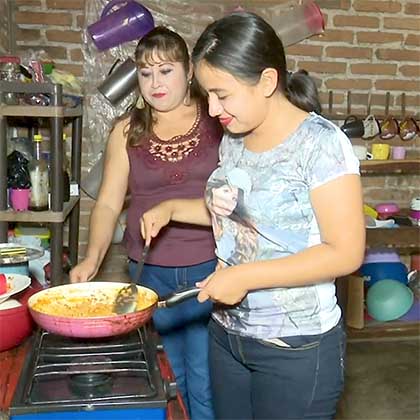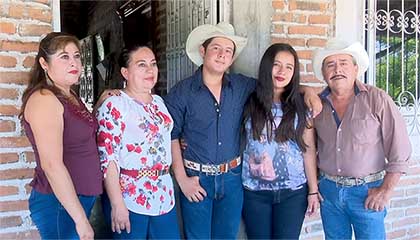Mexico
‘I said yes! I knew I wanted to be with him’
In rural Chiapas State, two teenagers marry, despite their parents’ disapproval.
Chiapa de Corzo, Mexico Estrella was in the sixth grade when Hendrin insisted, with the urgency of young love, that they spend the rest of their lives together.
“I was unsure because of my studies,” she says. “But since I love him so much, well, yes. I said yes! I knew I wanted to be with him.”
On Aug. 25, 2018, over the initial objections of their parents, Estrella Belen Estrada Rodriguez married Hendrin Gonzalez Melchor and settled at his family’s small ranch in the poor, southern state of Chiapas. She was 13. He was 15.
“God willing, my daughter will be all right,” says Maria Eugenia Rodriguez Valbuena, repeating concerns shared by her husband. She clutches Estrella’s hand, as the two sit outside the Gonzalez house a few days before the wedding. She’s taking a break from sewing her daughter’s wedding gown.
By the numbers

Mexico
| 26% | 4% |
| Married by 18 | Married by 15 |
No progress has been made in reducing the prevalence of child marriage in Mexico for the last three decades, according to UNICEF. This is a similar trend seen across Latin America and the Caribbean, which unlike other regions of the world, has seen stagnant levels of child marriage.
| Regional comparison | Married by 18 |
|---|---|
| Nicaragua | 35% |
| Honduras | 34% |
| Guatemala | 30% |
| El Salvador | 26% |
| Panama | 26% |
| Mexico | 26% |
| Belize | 26% |
| Costa Rica | 21% |
Select a country to explore how it compares to the region.
The teens’ coupling offers a snapshot of child marriage in Latin America and the Caribbean, the only region in the world where early unions are increasing overall, though slightly, according to Girls Not Brides, a global coalition of groups opposed to the practice.
Across countries, marriage before 18 shares common factors. It mostly affects girls with limited access to education who come from low-income households in poor, rural areas, UNICEF says. Research indicates that halting early wedlock can not only raise living standards for girls and their families, but also can improve a nation’s prosperity.
Mexico bans before-18 marriage
In early June, Mexico’s government announced a ban on marriage before age 18, overruling many state laws that permit marriage — with parental consent — for males as young as 16 and girls as young as 14.
Mexico joins most other Latin American countries in setting 18 as the age of consent, according to Girls Not Brides. Some countries, especially in the Caribbean, have no established minimum. Ana Lucia Cabrera, an advocacy specialist for Save the Children’s operations in Latin America, objects that by giving their consent to an early marriage, parents surrender responsibility for the well-being of a minor to someone outside her family. In many cases, it’s to an older man who might show less interest in her welfare.
In Mexico, roughly 1 in 4 girls winds up married or in a live-in relationship by age 18, UNICEF reports. The practice is even more common in rural, indigenous communities such as Chiapa de Corzo, where VOA affiliate Azteca News found Estrella and Hendrin. In such locales, almost 1 in 3 girls marries young.
Informal cohabitation almost triples the marriage rate among underage couples in Latin America. In Mexico alone, it accounts for 4 out of 5 early unions, Girls Not Brides reports, citing data from the Mexican health and demographic research firm INSAD. It says teenage pregnancy plays a role in roughly half of early unions.
Early unions impede schooling
Only 1 in 10 girls (92%) in married or informal unions in Mexico returns to school, according to INSAD, noting that household responsibilities or pregnancy often get in the way. Married girls who want to resume their education may face discrimination and isolation, particularly if they’re visibly pregnant.
School administrators send the message, subtly or directly, that “we don’t want you here because you’re a bad example for the rest of your peers,” says Eugenia Lopez Uribe, Girls Not Brides’ senior officer in Latin America.
Near Chiapa de Corzo, Estrella has shifted her focus from schoolwork to getting educated in domestic arts. Under her mother-in-law’s instruction, she has learned to make her husband’s breakfast eggs, wash clothes and clean house, while Hendrin tends to the livestock and fieldwork on the family ranch. He, too, dropped out of school.
“Now, well, I have to take care of my husband,” Estrella cheerily explains. “I wake up early. I have his coffee ready by 5:40 or 6 a.m. Then afterward, I start to clean the house, wash the dishes, clean his clothes — everything, no?”

Under the supervision of her mother-in-law, left, Estrella, married at 13, learns to cook. She wakes up early to have her husband’s coffee ready by 5:40 a.m. or 6 a.m. (Photo by Ery Acuna Meneses for VOA News)
Parents worry
Neither Hendrin’s nor Estella’s parents envisioned marriage for their children at such tender ages.
When Hendrin told his father about his marriage plans, “He took me … behind the house, and he scolded me, and he hit me,” the teenager says.
Within a few days, his father relented.
“If I kicked them out, they might pick up a bad habit — some vice or a drug addiction — and that would be my fault,” Corazon Gonzalez Ruiz explains. “What I have ended up doing is better, supporting them as much as I possibly can.”
Estrella’s parents also were distraught when she left home without explanation.
“It hurt me a lot when she left. It’s a real anguish,” Valbuena admits. “But then we finally learned that she was here with the boy.”
Valbuena says her husband also was disappointed but somewhat reassured because Hendrin’s mother, Cora, is a longtime friend.

Estrella and her husband, Hendrin, are surrounded by their parents, who initially disapproved of the marriage. (Photo by Ery Acuna Meneses for VOA News)
OAS urges change
Almost a year into the marriage, Estrella and Hendrin say they are happy with their situation. Nonetheless, the national government wants to see fewer unions like theirs. That’s also true of the Organization of American States (OAS), which has urged its 34 member nations to support the U.N. goal of ending child marriage.
A 2016 OAS forum on the issue led to recommendations for building awareness, strengthening data collection, reforming laws and public policies — as with Mexico’s ban — and coordinating government, academic and civil society responses.
Recommendations and revised laws are not enough, says Lopez Uribe of Girls Not Brides, who wants to broaden girls’ access to education and health care and break down socioeconomic barriers.
Girls “need tools and resources to develop their full potential and worth,” she says.
Ery Acuña Meneses, a staff journalist with TV Azteca, reported from Chiapa de Corzo, Mexico. Lina Correa of VOA Spanish Service reported from Washington, D.C.
Global perspective
| 10% | 20% | 30% | 40% | 50% | 60% |

Jajaja Se salen de casa de sus padres para vivir con los suegros A los 16 que diablos me iba a casar mi papa siempre me aconsejo estudia, trabaja, viaja come lo que quieras comer, vive y disfruta con responsabilidad tu juventud y ya luego te casas. Me case ya grande Y fue la mejor decision de mi vida.
TRANSLATION: Ha-ha-ha. They leave their parents’ house to go live with their in-laws. At 16, no way I was going to get married. My dad always advised me, “Study, work, travel, eat what you want to eat, live and enjoy responsibly your youth and then later you get married.” I got married when I was older, and it was the best decision of my life.
Yolizz Castillo Pinedha
What do you think? Add your voice to the conversation on Facebook.